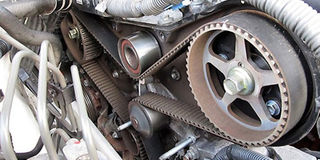Why you should care about the timing belt

Location of the timing belt. Photo by Mustafa Ziraba
What you need to know:
- When the timing belt is replaced, the mechanic also replaces the tensioner, a device that keeps the timing belt tight.
- While replacing a timing belt is easy with many common cars, Settimba cautions that with some complex engines the mechanic must be prepared to work in extremely tight spaces using specialised tools.
When you own an old car, you tend to spend most of your Saturday afternoons in the company of your trusted mechanic. And sure enough he or she, more often than not, shall keep reminding you about the imminent danger if you do not replace your timing belt.
Sulaiman Settimba, a mechanic on Salaama Road, says having the timing belt replaced at recommended intervals is critical for the smooth operation of a car. At the very least, a failed belt can put a car out of commission until a new one can be installed, but in some cases, it can cause a catastrophic engine failure.
What’s a timing belt?
Settimba says it is the ribbed belt that is placed in a specific configuration along one side of your engine to keep the top half of the engine in sync with the bottom half.
If you have an older car from the early 2000s and below specifically Japanese makes, odds are you have a timing belt. For longevity, many manufacturers have switched to metal timing chains that in theory last for the life of the engine.
“Not to be confused with the V-Belt which is usually visible on all engines when you open the bonnet. This one typically runs the peripheral systems on the engine such as the A/C pump, power steering pump, alternator and water pump. The timing belt is normally in a closed section of the engine,” he says.
When to replace
Settimba says you should replace your timing belt upon reaching the mileage interval specified by your car manufacturer. For most cars, this is usually between 100,000 and 150,000 kilometres. “A timing belt’s design is built to last, with sturdy rubber and reinforcing metal strips, but eventually the belt will wear out, and the engine will not be able to function. In many cases, the timing belt will break while the engine is running. A replacement should ideally be performed before the belt fails,” Settimba says. Different manufacturers have their own recommendations, making it advisable to consult a mechanic.
Tensioner
When the timing belt is replaced, the mechanic also replaces the tensioner, a device that keeps the timing belt tight. It is not unusual for a mechanic to suggest replacing the water pump at the same time as the timing belt, even if there is no obvious damage.
It is not a requirement to take this advice, but it may pay off in the long run. Almost all of the labour required to replace a water pump has already been accomplished while replacing the timing belt. If the water pump should fail later on, the mechanic would have to go through all of those preliminary steps again.
While replacing a timing belt is easy with many common cars, Settimba cautions that with some complex engines the mechanic must be prepared to work in extremely tight spaces using specialised tools. “Just know that timing belts have a limited life span. There are usually no indications of their impending failure either. They simply rip or snap while you are driving and leave you stranded, often at the worst possible time too,” he says.



